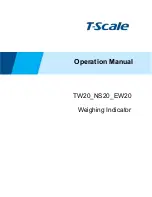
TABLE OF CONTENTS
1.0 INTRODUCTION ................................................................................................................................................ 1
1.1 A Quick Word about Accuracy ............................................................................................................... 1
1.2 Typical Uses ............................................................................................................................................ 2
1.3 Frequency Range ..................................................................................................................................... 4
2.0 POWER SOURCES ............................................................................................................................................. 4
2.1 External Power Supply ............................................................................................................................ 4
2.2 Using Internal Batteries ........................................................................................................................... 4
2.3 Using Rechargeable “AA” Type Batteries .............................................................................................. 5
2.4 Using Conventional “AA” Drycell Batteries........................................................................................... 5
2.5 “Power Saving” Mode (sleep mode) ....................................................................................................... 6
3.0 MAIN MENU AND DISPLAY............................................................................................................................ 6
3.1 General Connection Guidelines............................................................................................................... 6
3.2 Power-up Display .................................................................................................................................... 7
3.3 Main MODE descriptions........................................................................................................................ 7
3.4 Blinking “VOLTAGE LOW” display warning ....................................................................................... 8
4.0 MAIN (OR OPENING) MODE ........................................................................................................................... 8
4.1 General Connection Guidelines............................................................................................................... 9
4.2 Antenna SWR .......................................................................................................................................... 9
4.3 Coax Loss ................................................................................................................................................ 11
4.4 Capacitance.............................................................................................................................................. 11
4.4 Inductance................................................................................................................................................ 12
5.0 ADVANCED OPERATION ................................................................................................................................ 14
5.1 Forward.................................................................................................................................................... 14
5.2 General Connection Guidelines............................................................................................................... 15
5.3 (Magnitude of) Impedance mode............................................................................................................ 15
5.4 Return Loss and Reflection Coefficient mode ........................................................................................ 16
5.5 Distance to Fault mode ............................................................................................................................ 16
5.6 Resonance Mode...................................................................................................................................... 18
5.7 Percentage Transmitted Power ................................................................................................................ 18
6.0 ADJUSTING SIMPLE ANTENNAS................................................................................................................... 19
6.1 Dipoles..................................................................................................................................................... 19
6.2 Verticals................................................................................................................................................... 19
6.3 Tuning a simple antenna.......................................................................................................................... 19
7.0 TESTING AND TUNING STUBS AND TRANSMISSION LINES .................................................................. 20
7.1 Testing Stubs ........................................................................................................................................... 20
7.2 Velocity Factor of Transmission Lines ................................................................................................... 21
7.3 Impedance of Transmission Lines or Beverage antennas........................................................................ 22
7.4 Adjusting Tuners ..................................................................................................................................... 23
7.5 Adjusting Amplifier Matching Networks................................................................................................ 23
7.6 Testing RF Transformers......................................................................................................................... 24
7.7 Testing Baluns ......................................................................................................................................... 24
7.8 Testing RF Chokes .................................................................................................................................. 25
8.0 TECHNICAL ASSISTANCE............................................................................................................................... 25


































